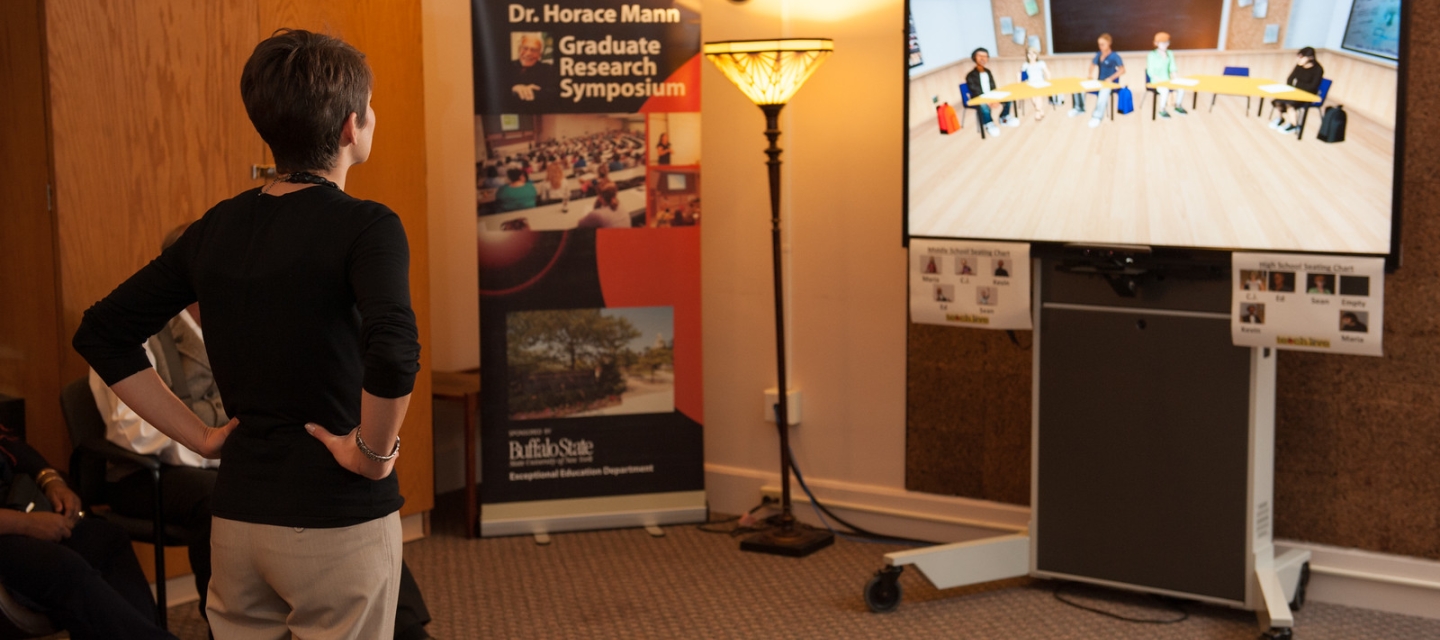

TLE TeachLivE™ is a computer-simulated, immersive, mixed-reality classroom that provides teachers the opportunity to develop their pedagogical practice in a safe environment that doesn’t place real students at risk. Teachers step into TeachLivE™ virtual classroom and within a minute experience immersion and suspension of disbelief, allowing them to rehearse high-leverage teaching practices related to student achievement. Much like a flight simulator for pilots, TeachLivE™ simulates a classroom experience for teachers to hone their skills.
The use of TLE TeachLivE™ Lab has been utilized in several clinically-based research projects. Such projects have included improving transition skills for students with significant disabilities, providing immediate feedback through bug-in-ear technology to pre-service teachers, developing discreet trial skills in pre-service and in-service teachers, and preparing teachers to become proficient in the use of STEM-related instructional strategies.
Buffalo State is the only college in the SUNY system currently using this unique mixed reality environment to prepare or retrain pre-service and in-service teachers.
Research
The Effects of Varying Levels of Professional Development on the Performance and Perceptions of Practicing Teachers
The TeachLivE virtual classroom at Buffalo State and the TLE TeachLivE high school student avatars are part of a national research study with the Bill & Melinda Gates Foundation. Currently 240 high school biology teachers across the country are participating in research. This project focuses on educators who want to learn about the new Next Generation Science Standards and Common Core Standards for Science Literacy while taking part in fun, innovative professional development.
This research project has three primary objectives:
1. To determine the efficacy of virtual rehearsal (i.e., repeated practice with feedback in an immersive environment) in the TLE TeachLivE™ simulator classroom on teacher practice in terms of increasing targeted pedagogical strategies and generalization of those strategies to a traditional classroom setting.
2. To explore participants’ reactions to the TLE TeachLivE™ simulator, including perceptions of suspension of disbelief and presence.
3. To compare the performance of teachers receiving professional development in two formats: Using the virtual rehearsal method in the TeachLivETM simulator, and using traditional professional development delivered in a workshop format.
Enhancing Fidelity of Implementation of System of Least Prompts among Novice Teachers of Students with Autism
Purpose of the study
This research project has two research questions:
To what extent is the fidelity of implementation of System of Least Prompts (SLP) affected when participants are prepared using individualized clinical coaching in the TLE TeachLivE™ virtual classroom laboratory?
To what extent did participants value their preparation of System of Least Prompts (SLP) with individualized clinical coaching while in the TLE TeachLivE™ virtual classroom laboratory?
Results
Results from visual analysis of this study suggest individualized clinical coaching (ICC) in TLE was successful in increasing fidelity across all participants while implementing SLP. Each participant met criteria (80% over three consecutive sessions) in a brief period (average of four, 15 minute sessions) of intervention and maintained an average well above criterion mastery during post-treatment sessions.
Results regarding social validity indicated that all participants highly agreed on the appropriateness of the text selection, procedures used to teach the skill of SLP (the coaching intervention), and inherent value of gaining knowledge in utilizing the SLP in general curriculum. Participants stated that they benefited from the reflection process (i.e., AAR journal) and ICC. Specifically, participants mentioned how the reflection helped them write down thoughts and acknowledge where they felt they were in most need of improvement. In addition, participants reported that they benefited from the modeling and 1:1 feedback. Participants said that the experience felt similar to working with a real student, that the avatar’s mannerisms as a student with ASD were “pretty natural”. Participants discussed the ease by which they were able to suspend disbelief. One participated commented, “I absolutely felt I was there [in the classroom].” In addition, several participants firmly believed learning about the SLP in the TeachLivE lab was a more valuable and intensified experience than just using a textbook. Several participants mentioned that they would prefer to pay for time in the lab in lieu of buying a traditional textbook. Overall, participants highly valued their preparation of the SLP when receiving ICC in the classroom simulation lab.
TeachLivETM from New York: Developing Innovative Practices in Immersive Teaching Technology
The goal of this project is to pilot the TLE TeachLivE™ virtual simulation classroom laboratory among interested departments at the college, local k-12 administrative personnel, and SUNY Institutes of Higher Education (IHEs). The project will explore opportunities for leveraging the power of SUNY to create an innovative academic program through which students and faculty across a range of disciplines and SUNY colleges collaborate to infuse in-vivo learning within the safety of the simulation lab to effectively prepare and enhance teacher preparation programs within the SUNY system.
This project has five objectives:
- Three separate missioned full day sessions will occur to assist stakeholders in the development and infusion of TeachLivE™ into curricula. The project will investigate design facility, and disseminate an innovative and replicable preparation model of seamlessly infusing pedagogy with evidence-based teaching techniques and classroom management strategies. A TeachLivE trainer will be present at all workshops; in person for the first session and virtually via skype for the following two.
- Undergraduate students in an exceptional education course will design and teach a class lesson within the TeachLivE lab setting. The PI will collect teacher candidate impact data via teaching rubric and survey instrument for evaluation
- Conduct a mixed methods research study. This study will investigate stakeholder learning experiences and best practice patterns among the disciplines. Personnel will examine the utility of the TLE TeachLivE™ simulation lab as a primer to classroom instruction in a variety of related courses; and determine the impressions of feasibility in establishing a TeachLivE™ simulation lab within various participants’ departments. Results will be disseminated through campus-wide and SUNY-wide channels. Project co-principal investigators and personnel will also disseminate findings at state and national conferences, and outcomes will be submitted to relevant journals for publication.
- Artifacts and results of research study will be disseminated through campus and SUNY-wide channels, including SUNY Learning Commons. Artifacts may include but are not limited to agendas for workshops, power points from workshop sessions, sample curricula, sample activities, project templates, and activity guides.
- Findings from this project will be presented at the SUNY CIT conference, as well as state and national level conferences. A manuscript on the research project will be developed and submitted to relevant peer reviewed journals for publication.
Publications
Andreasen, J. B. & Haciomeroglu, E. S. (2009). Teacher training in virtual environments. Paper presented at the annual meeting of the North American Chapter of the International Group for the Psychology of Mathematics Education, Atlanta, GA. Teacher Training in Virtual Environments.
Dieker, L., Hynes, M. & Hughes, C. (2008). Implications of mixed reality and simulation technologies on special education and teacher preparation. Focus on Exceptional Children, 40(6), 1-20.
Elford, M., Carter, R., & Aronin, S. (2013). Virtual reality check: Teachers use bug-in-ear coaching to practice feedback techniques with student avatars. JSD, 34(1), 40–43.
Hayes, A. T., Straub, C. L., Dieker, L. A., Hughes, C. E., & Hynes, M. C. (2013). Ludic Learning: Exploration of TLE TeachLivETM and Effective Teacher Training. Int. J. Gaming Comput. Mediat. Simul., 5(2), 20-33. doi: 10.4018/jgcms.2013040102
Hughes C. E. & Mapes, D. P. (2012). Mediated dialogues through multiple networked avatars. Journal of Immersive Education, in press. (Presented at iED 2012, Boston, Ma, June 14-16).
Long, W.A. (2011). Your predictable adolescent. Charleston, SC: BookSurge Publishing.
Lopez, A. L., Hughes, C. E., Mapes, D. P. & Dieker, L. A. (2012). Cross cultural training through digital puppetry. International Conference on Cross-Cultural Decision Making. San Francisco, July 21-25, 2012.
Mapes, D. P., Tonner, P. & Hughes, C. E. (2011). Geppetto: An environment for the efficient control and transmission of digital puppetry. Lecture Notes in Computer Science, Lecture Notes in Computer Science, Volume 6774, Springer-Verlag, Heidelberg, 270-278.
Vince Garland, K. M., Vasquez, E., & Pearl, C. (2012). Efficacy of individualized clinical coaching in a virtual reality classroom for increasing teachers’ fidelity of implementation of discrete trial teaching. Education and Training in Autism and Developmental Disabilities, 47(4), 502-515.
Walker, J. M. T., & Dotger, B. H. (2012). Because wisdom can’t be told: Using comparison of simulated parent–teacher conferences to assess teacher candidates’ readiness for family-school partnership. Journal of Teacher Education, 63(1), 62–75. doi:10.1177/0022487111419300
Zhu, J., Moshell, J. M., Ontañón, S., Erbiceanu, E. & Hughes C. E. (2011). Why can’t a virtual character be more like a human: A mixed-initiative approach to believable agents. Lecture Notes in Computer Science, Volume 6774, Springer-Verlag, Heidelberg, 289-296.

